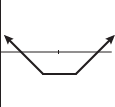-
Strangle

A long strangle buys a call and a put, both options have the same expiration date but both at out-of-the-money meaning the put has a strike price that is below the current price of the underlying stock and the call has a strike price that is above the current price of the undelrying stock. A long strangle would be executed if the trader expected the undelrying stock to make a big move but wasn't sure of the direction. As the strike prices get further from at-the-money the cost of the strangle decreases but the odds of it becoming profitable also decrease.
A short strangle sells both a call and a put with the same expiration. Again, both options are out-of-the-money. The maximum profit for a short strangle is the premium received. The maximum potential loss is infinite if the stock rallies.
See the OptionMath.com Strangle Cheat Sheet
| Strangle |  |
|
A long strangle buys a call and a put, both options have the same expiration date but both at out-of-the-money meaning the put has a strike price that is below the current price of the underlying stock and the call has a strike price that is above the current price of the undelrying stock. A long strangle would be executed if the trader expected the undelrying stock to make a big move but wasn't sure of the direction. As the strike prices get further from at-the-money the cost of the strangle decreases but the odds of it becoming profitable also decrease. A short strangle sells both a call and a put with the same expiration. Again, both options are out-of-the-money. The maximum profit for a short strangle is the premium received. The maximum potential loss is infinite if the stock rallies. See the OptionMath.com Strangle Cheat Sheet
|
||